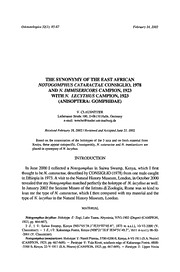
The synonymy of the East African Notogomphus cataractae Consiglio, 1978 and N. immisericors Campion, 1923 with N. lecythus Campion, 1923 (Anisoptera: Gomphidae) PDF
Preview The synonymy of the East African Notogomphus cataractae Consiglio, 1978 and N. immisericors Campion, 1923 with N. lecythus Campion, 1923 (Anisoptera: Gomphidae)
Odonatologica32(1):85-87 February 24. 2003 Thesynonymy of theEast African NotogomphuscataractaeConsiglio, 1978 andN. immisericors Campion, 1923 withN. lecythus Campion, 1923 (Anisoptera: Gomphidae) V.Clausnitzer Liebenauer Straße 180,D-06110 Halle,Germany e-mail: [email protected] ReceivedFebruary28,2002/ ReviewedandAcceptedJune21,2002 Based onthe examination ofthe holotypes ofthe 3taxa andon fresh materialfrom Kenya,theseappear conspeciftc.Consequently,N. cataractae andN. immisericors are placedinsynonymy ofN. lecythus. INTRODUCTION In June2000 Icollecteda Notogomphus in Saiwa Swamp, Kenya, whichI first thought tobeN. cataractae,describedby CONSIGLIO(1978) fromonemalecaught inEthiopiain 1973.AvisittotheNaturalHistoryMuseum,London,inOctober2000 revealedthatmyNotogomphus matchedperfectly theholotypeofN. lecythus aswell. In January 2002theSezioneMuseooftheIstituto diZoologia, Romewas sokindto loanmethe typeofN. cataractae,whichIthencompared with my materialandthe typeofN. lecythus intheNaturalHistory Museum,London. MATERIAL Notogomphuslecythus:Holotype 6:Zegi,LakeTsana, Abyssinia,V/VI-1902 (Degen)(CAMPION, 1923,pp.664-667). 2 <J, 1 9: Saiwa Swamp, Kenya(N01°05’38.1'’/E35o07’05.8”; 1875 m a.s.l.), 10-VI-2000 (V. Clausnitzer); - 1<5,19:KakamegaForest,Kenya(N00°2ri8.8”/E34°5r49.7”;1611 ma.s.l.),06-XI- -2001 (V.Clausnitzer). Notogomphusimmisericors:Holotype9:NandiPlateau,5700-6200ft,Kenya,4-VI-1911(S.A.Neave) (CAMPION, 1923,pp.667-669); — Paratype 9: Yala River,southern edgeofKakamegaForest,4800- -5300ft,Kenya,22-V-1911(S.A.Neave)(CAMPION, 1923,pp.667-669); - Paratype 9:UpperNzoia 86 V.Clausnitzer River,5100-5400 ft,KenyaColony,5-VI-1911 (CAMPION, 1923, pp.667-669). Notogomphuscataractae: Holotype 6:Kaffa,Uncuri, cascate del Piccolo Ghibie, ca 1650 m a.s.l., Ethiopia,29-X-1973(C.Consiglio)(CONSIGLIO, 1978). SPECIESCOMPARISONS NOTOGOMPHUSCATARACTAE. CONSIGLIO (1978)describedN. cataractae as a newspecies fromEthiopia fromasingle malehecaughtin 1973.His description and drawings are very similar to the ones CAMPION(1923) gave for N. lecythus and matchperfectly theholotypeofthisspecies intheNaturalHistory Museum,London.I compared thepenisstructureofboth types,andtheseare identical.CONSIGLIO(1978) didnotmentionN. lecythus asapotentialsimilarspeciesandthusdescribednofeatures to differentiatethetwo taxa. Fromthe description of N. cataractae by CONSIGLIO (1978)itisobviousthathedidnotcomparehisspecimen withthetypeofN. lecythus. ThemaindifferencebetweenConsiglio’s descriptionofN. cataractaeandCampion’s description ofN. lecythus isthepresenceoftwofaintbandsnear thehumeralsuturein thebrownarea inthelatterspecies. Inaspecimen IcaughtatSaiwaSwamp,WKenya, these markings wereonly very faintly visibleas a lighterbrownerarea inthe living specimenbutfadedwhenthespecimen became dry. CONSIGLIO(1978)wrotethathisN. cataractae “isdifferentfromallknownspecies ...andperhaps N. immisericorsCampion (distinguished by havingananalloopinthe hindwing)”.Thepresenceofananalloopis variableinfemalesintheNaturalHistory Museum,London,labelledN. immisericors andthusnota gooddifferentialfeature. NOTOGOMPHUSIMMISERICORS. — CAMPION(1923) describedA. immisericors as anewspecies, basedonthreefemales. N. lecythus is describedinthesamepaperand Campionreferstothesimilarityofbothspecies: “Inmanyrespects they [3 femalesof Notogomphus immisericors] areverysimilartothemaleheredescribedasN. lecythus, themoststrikingdifferencesbeing foundinthefemurofthehindleg,which carriesa powerful armature, and in the hind wing, which has a distinct anal loop and is considerablynarroweratthebase thanintheAbyssinian insectmentioned”(CAMPION, 1923,p.669). FromN. immisericors only the threetypefemales seemtohavebeencollectedand PINHEY (1961,p.75) wrotethatF.C.Fraser“believesit[N. immisericors] tobethe femaleoflecythus.” Thesimilaritieshavebeenalsodescribedby LONGFIELD(1936, pp.477-478):“Thecolour-pattern ofN. dorsalisis practicallyrepeated inthetypesof N. longus Martin,N. lecythus Campion andN. immisericorsCampion, andisalsovery similartothatofthegenoptye.They allhaveabasalsubcostalnervuleinallfourwings andlong hind femora”. Theonly differencegiven betweenN. lecythus andN. immisericors are the long spinesonthehindfemurinthelatter(CAMPION.1923;LONGF1ELD, 1936).Allmy specimen(malesandfemales),Consiglio’sN. cataractae andallthreefemalesdescribed as N. immisericorshavestrongspines onthehindfemur.ThetypeofN. lecythus has SynonymyofNotogomphuslecythusCampion 87 only thelefthindfemurleft, thetibiaandtarsus missing. Thisremaining hindfemur appearstohaveonly shortspines,butanumberofthemarebrokenlong spines,visible undera stereo microscope. Positionand diameterof thesenormally long spines are identicaltothoseofN. cataractae andN. immisericors. CONCLUSIONS Aftercomparing allspecimens listed, thereis no doubtthey belong toonespecies. Theholotype malesofN. lecythus andN. cataractae andmy males from western Kenya are identicalin colouring, anal appendages and penile organs. The femaleI collectedinwesternKenya is identicalincolouring,structureoftheprothorax andthe vulvarscaletotheparatypeofN. immisericors.ThereforeNotogomphus immisericors andN. cataractaeare synonyms ofN. lecythus. ACKNOWLEDGEMENTS Theauthorwishestothankfollowingpeopleandinstitutions forhelpandsupport:DAVIDGOODGER (NaturalHistory Museum,London), AUGUSTO VIGNATAGLIANTI(Sezione Museo, Istituto di Zoologia,Rome),RICHARDBAGINE(KenyaWildlifeService),LUCIE ROGO(InternationalCentre forInsectPhysiologyandEcology,Nairobi), WANJAKINUTHIA(NationalMuseumofKenya)andthe Wardens inChargeand the staffofthe SaiwaSwampNational Park andtheKakamegaForestReserve (bothKenyaWildlifeService).TheA.F.W.Schimper-Stiftung,theGermanScientificResearchFoundation (DFG)andtheGermanFederalMinistryofScience(BMBF,BIOLOGProgramme)arethankedforfunding thework. SABINEGRIESBACHiswarmlythankedforherhelpandhospitalityinNairobi. REFERENCES CAMPION,H., 1923. Descriptionsofthree speciesofNotogomphus(Odonata)from EastAfrica. Annls Mag.run.Hist.9(12):659-669. CONSIGLIO,C., 1978,Odonatacollected inEthiopiabytheexpeditionsoftheAccademiaNazionaledei Lincei. 2.New andrarespeciesofNotogomphusfromEthiopia.Problemi att.Sci. Cult. (Ill)243: 53-58. LONGFIELD,C., 1936.StudiesonAfricanOdonata,withsynonymyanddescriptionsofnewspeciesand subspecies.Trans.R. ent.Soc. Land. 85: 467-498. PINHEY,E„ 1961.Asurveyofthedragonfliesofeastern Africa.Brit.Mus.(Nat.Hist.),London.
